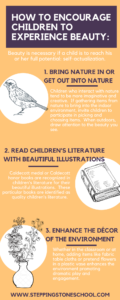The Necessity of Beauty
Four-year-old, Jamie stood motionless in front of a flower. Moving closer, I noticed a small white butterfly perched on the petal of a purple flower.
Jamie reverently whispered, “See the dot on its wings, it has the same on both!” Going on he said, “It’s so quiet. I like it.” Throughout the rest of the day, Jamie talked about the butterfly. He thought about which flowers it may like best, where it may fly to next, he even wondered if he stood really still whether or not it may think him a flower.
Jamie paused in the presence of a beautiful insect perched on a beautiful flower. The beauty of that moment caused him to ask questions, invited him to wonder, and to share his thoughts with others.
Beauty is necessary if a child is to reach his or her full potential: self-actualization.
Studying the works of Abraham Maslow, one begins to understand the importance of aesthetics. Admittedly, I do not recall hearing about “the need for beauty” during my undergraduate years. Yes, I studied Maslow’s Hierarchy of Needs in each of my education courses, but the emphasis was more on meeting the basic physiological needs and needs for safety before attempting to meet the cognitive needs of a child. Now I recognize the connection between the “aha” moment of discovery and the excited self-driven investigation into how a thing works are all centered around beauty. Beauty is the spark leading to each “aha.” It is the splendor of an object found in nature, the cause for pause when observing a work of art, and the movement born out of the feel of the lovely music.

How to encourage children to experience beauty:
- Bring nature in or get out into nature. Nature inspires each branch of academia in one form or another. Children who interact with nature tend to be more imaginative and creative. If gathering items from nature to bring into the indoor environment, invite children to participate in picking and choosing items. When outdoors, draw attention to the beauty you see.
- Read children’s literature with beautiful illustrations. Caldecott medal or Caldecott honor books are recognized in children’s literature for their beautiful illustrations. These particular books are identified as quality children’s literature.
- Enhance the décor of the environment. Whether in the classroom or at home, adding items like fabric tablecloths or pretend flowers in a plastic vase enhances the environment promoting dramatic play and engagement.
At Stepping Stone School, teachers provide weekly changes within the classroom environment to connect children with something beautiful to assist children in reaching the goal of self-actualization or reaching the state in which a person is driven “to maximize his or her personal potential capacities, and talents” (Maslow’s Hierarchy of Needs). Monthly trips to The Atelier™for Prekindergarten and School Age children, enable them to study men and women who reached their potential as artists, engineers, and people of character.
If we as caregivers, parents, and teachers desire children to experience more “aha” moments, we must provide them with opportunities to experience beauty.